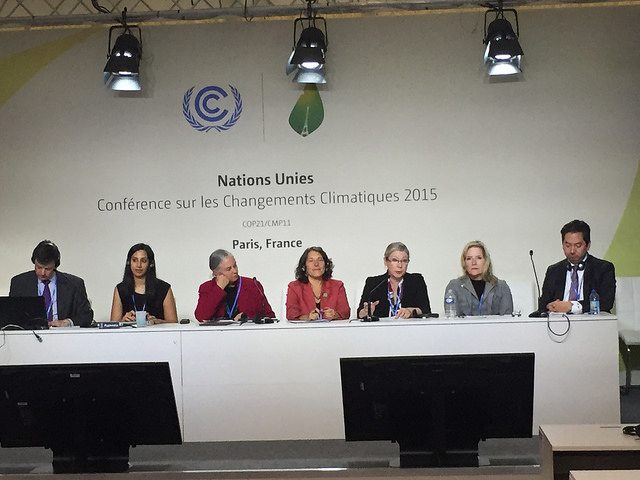聯合國氣候大會(COP21)零排放車輛(Zero Emission Vehicles, ZEVs)活動上,與會部長和來自汽車產業、公民社會和國際組織的資深代表表示,零排放車輛是氣候變遷因應的關鍵策略之一,呼籲快速往車輛零排放轉型。
不過,現今的運輸產業幾乎完全依賴化石燃料,在能源相關二氧化碳排放中佔了1/4。根據預測,運輸產業的排放比例將成長到總排放的1/3,而且成長速度比其他產業都快。
國際能源署(International Energy Agency,IEA)執行董事Fatih Birol認為,電動車可讓未來更乾淨永續。「IEA的資料顯示,若要將暖化控制在2°C內,2030年前至少全世界要有1/5的車輛是電動車。」
部分國家已經將電動車納入政策。在挪威,每四台售出的汽車中有一台是電動車。中國官員指出,中國現在有2億3000萬台電動腳踏車上路。在中國主要城市,10年前開始實施的政策已讓電動二輪和三輪車取代了汽油機車。
這樣的轉型必須擴大並複製到全世界。
聯合國人居署(United Nations Human Settlements Programme,UN-HABITAT )執行董事Joan Clos表示:「ZEV能減少不利健康與經濟的城市空氣污染。如果城市推動緊湊規劃(compact planning)和改善公共交通,電動車將更有機會興起,獲得豐碩成果。」
許多與會者相信,雖然全世界仍會繼續依賴化石燃料一段時間,但現在就是開始轉型的時刻。
2015年啟動、由11個創辦國家與地方成員組成的IEA電動車計畫、UN-Habitat都市電動車計畫和國際零排放車輛聯盟都在活動上展示。雷諾 - 日產聯盟提供200輛純電動車給COP21,是全球最大的電動車隊,法國能源商EDF也為COP21設立90個低碳充電站。
聯合國環境規劃署(UNEP)宣布一項新全球計畫,支持新興經濟體轉型電動運輸。
UNEP科技、產業和經濟部主任Ligia Noronha表示:「繼續使用化石燃料的氣候、空污和經濟成本太高。我們必須確保全球所有區域和國家,都往電動車輛轉型。
Ministers and senior representatives from the auto industry, civil society and international organizations Tuesday called for a rapid move to zero-emission vehicles as a key component of a future global climate change strategy.
The statement came at an event on Zero Emission Vehicles (ZEVs) at the Netherlands Pavilion at COP 21, the 21st Conference of the Parties to the United Nations Framework Convention on Climate Change now underway at the Paris–Le Bourget Airport.
The Renault-Nissan Alliance is providing 200 pure electric vehicles for COP21, the world’s largest EV fleet. A network of 90 charge spots has been set up to charge the vehicles using low-carbon electricity provided by French energy supplier EDF.
Yet, today’s transport sector is almost entirely dependent on fossil fuels. It contributes roughly one quarter of all energy related carbon dioxide emissions to the atmosphere.
And the transport sector’s emissions are projected to grow to one-third of all global CO2 emissions, and grow faster than any other sector.
Fatih Birol, executive director of the International Energy Agency believes the world needs many more electric cars.
“Electric vehicles can drive us into a cleaner, more sustainable energy future,” he said. “The IEA has shown that if global warming is to be limited to 2 degrees, at least a fifth of all vehicles on roads by 2030 should be electric.”
Leading by example, some countries have put in place policies to support the use of electric vehicles.
In Norway, for instance, one out of four cars sold is electric.
In China, there are 230 million electric bikes in on the roads, officials say. A national two and three-wheeler strategy that started 10 years ago has resulted in electric two and three wheelers having all but replaced petrol motorbikes in China’s major cities.
Such practices need to be scaled up and replicated around the world, the group urged.
Joan Clos, executive director of UN-Habitat, the UN Human Settlements Agency, had this to say. “ZEVs will also reduce local air pollution in cities that is causing immense damage to health and the economy. The uptake of electric-mobility will be more feasible and also fruitful if cities adopt compact planning and measures to improve public transport.“
Many of the event participants believe that while the world will still rely on fossil fuels for transportation for some time, the time is now to start a global shift to zero emissions vehicles.
The Electric Vehicles Initiative of the International Energy Agency, the Urban Electric Mobility Initiative of UN-Habitat, and the International Zero Emission Vehicle Alliance, launched in 2015 with 11 founding national and subnational members, were showcased at the event.
UNEP announced a new global program to support emerging economies to move to electric mobility.
UNEP’s Ligia Noronha, director of the Division of Technology, Industry and Economics, believes, “The continued use of fossil fuels for vehicles is costing too much – in terms of climate, air pollution and economies,” said Noronha. “To get the necessary benefits we need to ensure this will indeed be a global shift – in all regions and countries.”
※ 全文及圖片詳見:ENS




